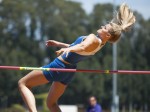Three weeks ago, the newest addition to UCLA’s track team made the journey across the Atlantic Ocean from Stockholm to Los Angeles to begin her life as a college student.
However, freshman high jumper Caroline Gyllenbern won’t be the only Swede on the team; she joins junior thrower Ida Storm and junior decathlete Marcus Nilsson to complete a Swedish trifecta.
UCLA has given Gyllenbern the chance to pursue higher education as a physiological sciences student while also developing her skills as an athlete, something that isn’t offered by universities in her home country.
“Here, you have the opportunity to combine academics and athletics in a very high standard,” Gyllenbern said. “You can’t really do that in Sweden. You have to choose between academics or athletics; you can’t really combine them.”
Storm and Nilsson had similar motives for choosing to attend a university thousands of miles away from home, but Nilsson also cited other factors such as weather and quality of training as contributing factors.
“For training, it’s warmer and stuff. For probably eight months (in Sweden), everything is indoors. It works, but it’s not like here, because it’s almost perfect weather in UCLA,” Nilsson said.
“And it’s really hard to find a good trainer back in Sweden too. … Right here, I mean, there’s so many good athletes all over and teams with good coaches.”
In Sweden, young athletes begin training at a track and field club. The elite athletes then embark on a path that helps groom their talent in track and field as they enter high school while still representing their clubs in competitions.
“We go to a normal high school, but there’s a program we’re in, where we’re getting a good coach, and we’re getting units in school for training,” Storm said.
Nilsson said that there are only a few schools in Sweden that offer specific help with track and field and similar, competitive experiences for their students.
Track and field has a larger public exposure in Sweden compared to the United States and is even occasionally broadcast on Swedish national airwaves. The athletes recall a track and field boom period from 2000–2007, when Sweden had several athletes competing on the international stage. Storm’s first foray into track and field occurred during this time.
“Sweden had good high jumpers when I was a kid, so when I was like 10 or so, I wanted to join in,” Storm said.
Gyllenbern started high jump after she was encouraged by teachers to start training at a club when they noticed during the school’s track and field day that she possessed a knack for it.
As for Nilsson, it was more of a family affair – his parents and three older siblings were all track athletes, and according to him, track and field has surrounded him for his entire life.
Gyllenbern graduated high school in the summer of 2012, but only made the decision to apply to a college in America in September. After committing to UCLA, Gyllenbern was offered a chance to begin classes early instead of waiting till next fall. She elected to take that option, but not without some apprehension.
Gyllenbern’s main concerns as she starts her third week of classes are fitting in with the rest of the freshmen who already have two quarters as UCLA students under their belts and her unfamiliarity with the American education system.
“I don’t know how much I’m supposed to study, and I don’t know what the level is here, how hard the tests will be, so I’m studying very hard right now to be safe, so I won’t be overwhelmed when the real test comes,” Gyllenbern said.
However, she finds comfort knowing that she can always turn to Storm and Nilsson for help and support.
“(Storm) has helped me a lot. Everything is so new, so different here. You get a lot of help otherwise from UCLA of course, but it just feels safe to have someone from the same country that has experienced the same thing and gone through the same thing,” Gyllenbern said.
